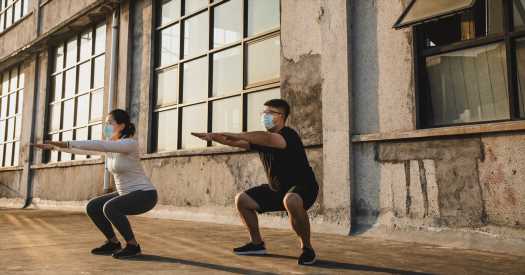Five minutes of burpees, jump squats and other calisthenics significantly improve aerobic endurance, according to one of the first randomized, controlled trials to test the effects of brief body-weight workouts. The study’s findings are predictable but reassuring, at a time when many of us are relying on short exercise sessions in our homes to gain or retain our fitness. They provide scientific assurance that these simple workouts will work, physiologically, and our burpees will not be in vain.
Last year, when the pandemic curtailed traditional gym hours and left many people hesitant to exercise outside on crowded sidewalks or paths, quite a few of us moved our workouts indoors, into our living rooms or basements, altering how we exercise. Some of us purchased stationary bicycles and started intense spin classes or turned to online personal trainers and yoga classes. But many of us started practicing some version of a body-weight routine, using calisthenics and other simple strength-training exercises that rely on our body weight to provide resistance.
Body-weight training has been a staple of exercise since almost time immemorial, of course. Usually organized as multiple, familiar calisthenics performed one after another, this type of exercise has gone by various names, from Swedish Exercises a century ago to the Royal Canadian Air Force’s Five Basic Exercises (5BX) program in the 1960s, to today’s Scientific 7-Minute Workout and its variations.
In general, one of the hallmarks of these programs is that you perform the exercises consecutively but not continuously; that is, you complete multiple repetitions of one exercise, pause and recover, then move on to the next. This approach makes the workouts a form of interval training, with bursts of intense exertion followed by brief periods of rest.
Traditional interval training has plenty of scientific backing, with piles of research showing that a few minutes — or even seconds — of strenuous intervals, repeated several times, can raise aerobic fitness substantially. But the exercise in these studies usually has involved stationary cycling or running.
Few experiments have examined the effects of brief body-weight workouts on endurance and strength, and those few had drawbacks. Most focused on people who already were fit, and almost none met the scientific gold standard of being randomized and including an inactive control group. Consequently, our faith in the benefits of short body-weight training may have been understandable, but evidence was lacking.
So, for the new study, which was published this month in the International Journal of Exercise Science, researchers at McMaster University in Hamilton, Ontario, and the Mayo Clinic in Rochester, Minn., decided to develop and test a basic body-weight routine. They modeled their version on the well-known 5BX program, which once had been used to train members of the Canadian military in remote posts. But the researchers swapped out elements from the original, which had included exercises like old-fashioned situps that are not considered particularly good for the back or effective in building endurance.
They wound up with a program that alternated one minute of calisthenics, including modified burpees (omitting the push-ups that some enthusiasts tack onto the move) and running in place, with a minute of walking, also in place. The routine required no equipment, little space and a grand total of 11 minutes, including a minute for warming up and cooling down.
They then recruited 20 healthy but out-of-shape young men and women, measured their current fitness, leg power and handgrip strength and randomly assigned half to start practicing the new program three times a week, while the others continued with their normal lives, as a control.
The exercisers were asked to “challenge” themselves during the calisthenics, completing as many of each exercise as they could in a minute, before walking in place, and then moving to the next exercise.
After six weeks, all of the volunteers returned to the lab for follow-up testing. And, to no one’s surprise, the exercisers were more fit, having upped their endurance by about 7 percent, on average. Their leg power also had grown slightly. The control group’s fitness and strength remained unchanged.
“It was good to see our expectations confirmed,” says Martin Gibala, a professor of kinesiology at McMaster University, who oversaw the new study and, with various collaborators, has published influential studies of intense interval training in the past.
“It seemed obvious” that this kind of training should be effective, he says. But “we now have evidence” that brief, basic body-weight training “can make a meaningful difference” in fitness, he says.
The study was small and quite short-term, though, and looked at the effects only among healthy young people who are capable of performing burpees and jump squats. “Some people may need to substitute” some of the exercises, Dr. Gibala says, especially anyone who has problems with joint pain or balance. (See the Standing 7-Minute Workout for examples of appropriate replacements, in that case.)
But whatever mix of calisthenics you settle on, “the key is to push yourself a bit” during each one-minute interval, he says.
Here is the full 11-minute workout used in the study, with video links of each exercise by Linda Archila, a researcher who led the experiment while a student at McMaster University.
1 minute of easy jumping jacks, to warm up
1 minute of modified burpees (without push-ups)
1 minute of walking in place
1 minute of high-knee running in place
1 minute of walking in place
1 minute of split squat jumps (starting and ending in the lunge position, while alternating which leg lands forward)
1 minute of walking in place
1 minute of high-knee running in place
1 minute of walking in place
1 minute of squat jumps
1 minute of walking in place, to cool down
Source: Read Full Article
